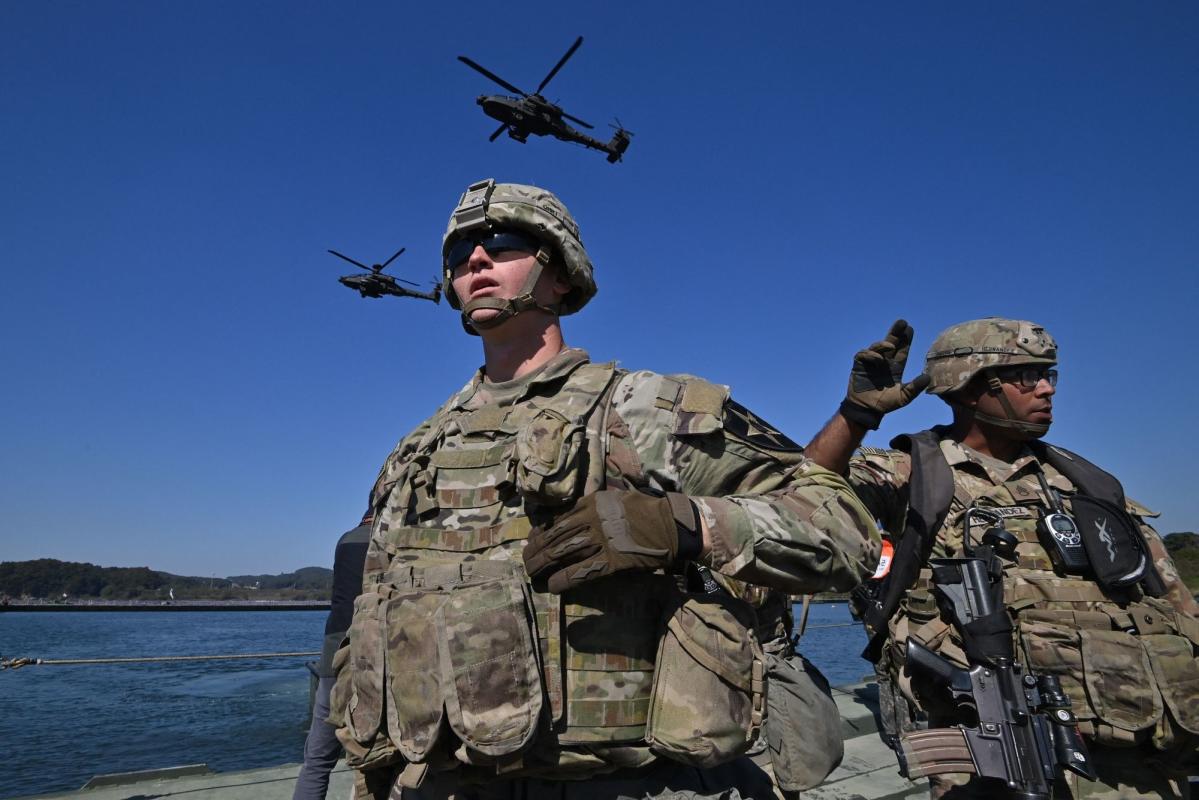
(Bloomberg) — North Korea fired at least 23 missiles Wednesday including the first ballistic one to fly over a nautical border with South Korea, in its biggest daily barrage under leader Kim Jong Un.
Most Read from Bloomberg
The launches came about a day after Pyongyang threatened to take “powerful measures” if the US doesn’t halt military drills with partners including South Korea, in what might be an effort by Kim to lay the groundwork for his first nuclear test in five years.
South Korean President Yoon Suk Yeol called the launch a territorial violation, and his country responded a few hours after barrages were fired off in the morning by firing three air-to surface missiles into international waters on North Korea’s side of the sea border known as the Northern Limit Line. South Korea also closed some air routes east of the peninsula for safety reasons, the transport ministry said.
The North Korean missiles were fired in batches that included four short-range ballistic missiles at 6:51 a.m., three short-range ballistic missiles at 8:51 a.m. and 10 missiles of various types fired to the east and west at 9:12 a.m., South Korea’s Joint Chiefs of Staff said. It confirmed an additional six surface-to-air missiles were shot off later in the day and that Pyongyang also fired about 100 artillery shells into a maritime buffer zone off the east coast.
One of the missiles fired at about 8:51 a.m. fell into international waters some 26 kilometers (16 miles) south of the sea border known as the Northern Limit Line, it said.
‘Unprecedented’ Provocation
US Secretary of State Antony Blinken and South Korean Foreign Minister Park Jin discussed the launches and condemned what they saw as an “unprecedented” military provocation, the Foreign Ministry in Seoul said in a statement.
The missiles triggered the first ever air raid alert on South Korea’s Ulleung Island, about 100 kms east of the coast. South Korea last sounded such a warning in 2016, after a long-range rocket launched by North Korea prompted an alert on an island near a western sea border, an interior ministry official said.
South Korea protested the launches, which came as it was in a national mourning period for 156 people killed in a crowd crush at a nightlife district in Seoul over the weekend. South Korea’s military also raised its alertness level, Yonhap News Agency reported.
South Korean and Japanese defense stocks advanced after North Korea began its latest short-range ballistic missile barrage, with Hanwha Aerospace Co. surging as much as 5.9% to its highest since Sept. 26.
The tit-for-tat missile exchange is an escalation of tensions after the two Koreas on Oct. 24 fired warning shots at each near a nautical border on the west side of the peninsula. Earlier that day, Seoul said a merchant vessel from its neighbor crossed the sea border. That exchange coincided with the US and South Korea beginning joint naval drills that included warships such as guided-missile destroyers.
“We have been in the season of North Korean provocations for the past couple months, so the latest missile launch should not be seen as an anomalous behavior,” said Soo Kim, a policy analyst with the Rand Corp. who previously worked at the Central Intelligence Agency.
The largest single-day ballistic missile barrage under Kim had been on June 5 of this year when North Korea fired eight short-range missiles from four locations within about 35 minutes, South Korea’s military said. The test appeared to be a demonstration of the state’s ability to quickly deploy and fire off missiles from various sites, which could make it difficult for US-operated interceptors in the region to shoot them down.
The US and South Korea this week started air drills known as Vigilant Storm that will run through Friday and involve about 240 aircraft in about 1,600 sorties to “hone their wartime capabilities,” the US 7th Air Force said in a statement. The drills have added to a series of joint exercises on land, sea and air in recent weeks, some of which have also included Japan, that have led to complaints and provocations from Pyongyang.
Since the end of September, when the USS Ronald Reagan aircraft carrier group was in the region for exercises, North Korea has fired one of its biggest barrages of missiles under Kim.
The US, Japan and South Korea have warned Kim could soon raise the stakes even higher with a nuclear test, which would be its first in five years and seventh overall. Washington, Tokyo and Seoul have all promised a harsh and coordinated punishment if Pyongyang sets off an atomic device, which would be a violation of United Nations Security Council resolutions.
The test might be used to advance Kim’s pursuit of miniaturized nuclear warheads to mount on missiles to strike South Korea and Japan, which host the bulk of America’s troops in Asia.
The North Korean leader is finding space to ramp up provocations as the Biden administration focuses on Russia’s war in Ukraine. Russia and China, two long-time partners of North Korea, have veto power at the UN Security Council and have shown no intent to punish Kim with extra sanctions.
“North Korea has made it clear, at the highest levels of the government, that it will respond to US and South Korean military drills in kind, and it will not back down,” said Rachel Minyoung Lee, a regional issues manager at the Vienna-based Open Nuclear Network who worked as an analyst for the CIA’s Open Source Enterprise for almost two decades.
“We can thus expect North Korea to continue stepping up military activities and weapons tests,” she said, adding this could include an inter-Korean military conflict in the Yellow Sea and a seventh nuclear test.
–With assistance from Sophie Jackman, Shinhye Kang, Seyoon Kim, Philip Glamann, Youkyung Lee and Muneeza Naqvi.
(Updates with additional missiles in lead, third paragraph.)
Most Read from Bloomberg Businessweek
©2022 Bloomberg L.P.




